This post is also available in: English
If there’s one tradition that truly captures the beauty, devotion, and artistry of Semana Santa in Antigua Guatemala, it’s the sawdust carpets, or alfombras. These colorful works of art are created directly on the cobblestone streets—only to be walked over and destroyed within hours.
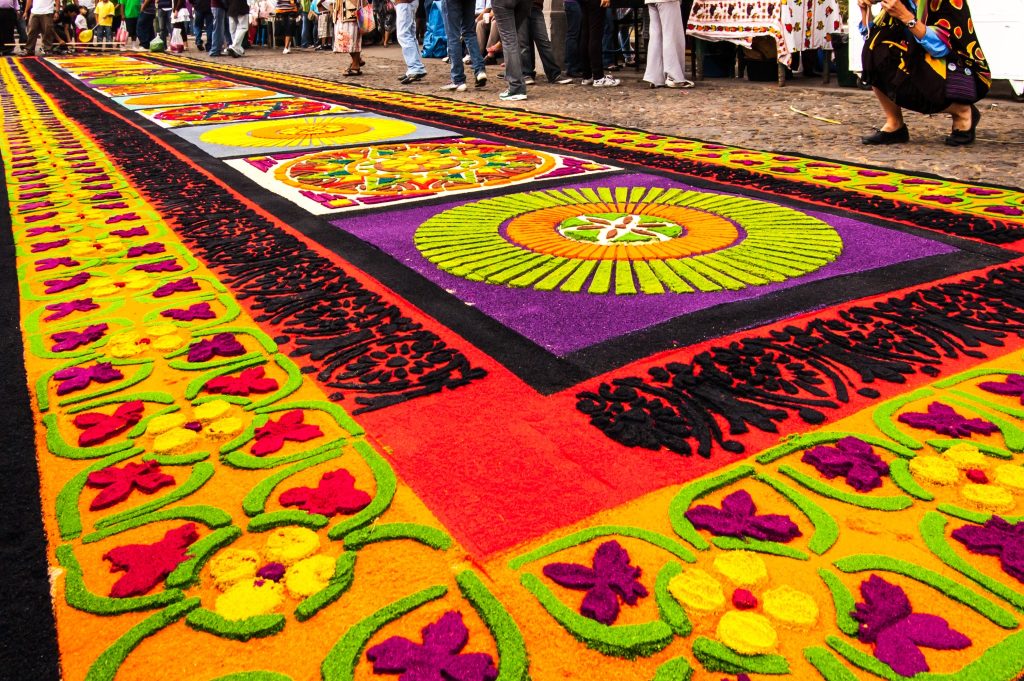
During Holy Week in Antigua, these carpets cover the city like a temporary gallery, made with dyed sawdust, flowers, pine needles, and even fruits and vegetables. They’re breathtakingly beautiful, and part of what makes Semana Santa one of the most unforgettable cultural events not just in Guatemala, but anywhere in the world.
When I was in my early twenties, my mom lived in Antigua. A small procession would pass right in front of her house, and I remember gathering fallen jacaranda blossoms from the yard to use in our alfombra. All the neighbors on the block would come out—we didn’t use stencils or plan anything fancy. Each family just took a section of the street and made their own design using whatever flowers and pine needles they had. It was simple, spontaneous, and full of heart.
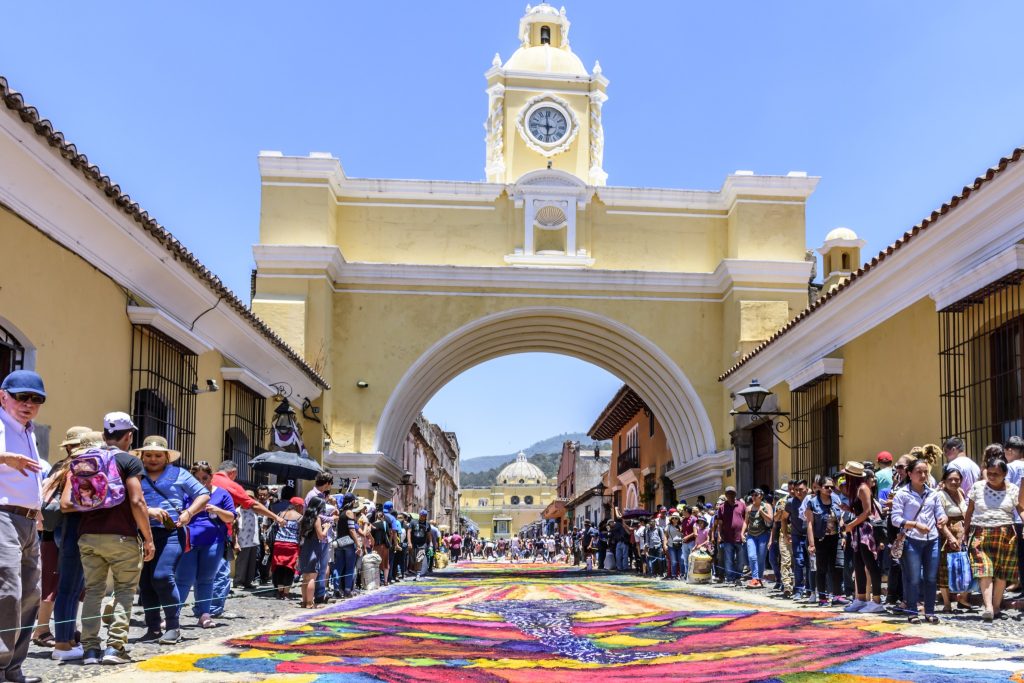
Things are different now. Semana Santa has grown into an international event. People come from all over—from Japan to Germany—to witness the processions and photograph the carpets. Many of today’s alfombras are intricate, professional-level art pieces that take months of planning. I once asked a local artist how long it took to prepare theirs and she just smiled and said, “We started the moment last year’s ended.”
Still, whether simple or elaborate, handmade with love or layered with symbolism, these carpets are something you’ll never forget—and they’re at the very heart of Semana Santa in Antigua Guatemala.
What Are the Holy Week Alfombras? The Meaning Behind the Sawdust Carpets of Semana Santa in Antigua Guatemala
Alfombras are one of the most beautiful and symbolic traditions of Semana Santa in Antigua Guatemala. These temporary “carpets” are created directly on the cobblestone streets, made to honor the processions that pass over them. They’re a form of devotion, art, and community all rolled into one.
The word alfombra means “carpet” in Spanish, and that’s exactly what they look like—massive, colorful rugs stretched out along entire city blocks. They’re made from a mix of materials, but one thing they all have in common is that they’re created with love, patience, and deep intention. For many families, making an alfombra is just as meaningful as walking in the procession itself.

The first time I walked through Antigua during Holy Week and saw an entire street glowing with bright pinks, purples, and yellows from a sawdust carpet at dawn, it took my breath away. The smell of pine needles, corozo, and incense in the air made it even more magical. There’s something sacred about knowing this beautiful thing was made just to be stepped on—and that its destruction is part of the ritual.
Types of Alfombras You’ll See During Semana Santa
While the brightly colored sawdust carpets are the most famous, there are several different types of alfombras you’ll come across during Semana Santa in Antigua Guatemala—each with its own unique look and meaning:
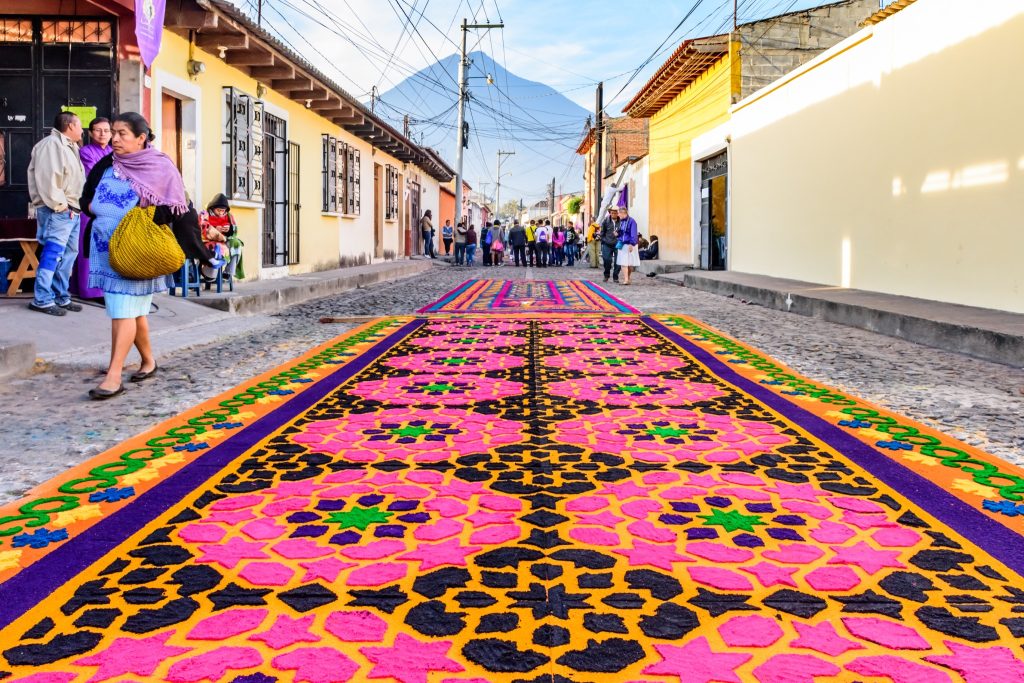
Sawdust Alfombras (Aserrín)
These are the most iconic. Made with dyed sawdust layered onto the street using stencils or freehand designs, they often include religious symbols, biblical scenes, or geometric patterns. Some take up to 24 hours to complete and stretch for blocks.

Flower Carpets
Made entirely from flower petals, leaves, and pine needles, these are common in more traditional neighborhoods or where the streets are too uneven for sawdust. They’re fragrant, delicate, and often simpler in design but just as stunning.
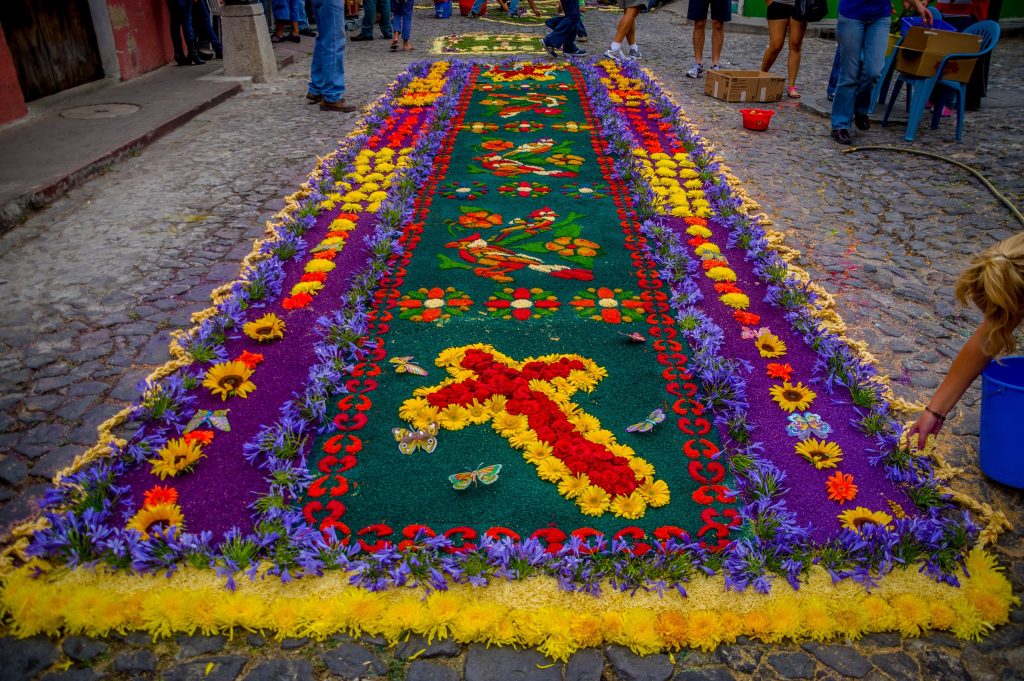
Mixed-Media Alfombras
Some families get creative and use everything from egg shells, candles, pinecones, or even marbles and glitter. These are often made by groups who want to add a personal touch or tell a specific story.
Fruit and Vegetable Alfombras (Huertos)
These are typically found inside churches, displayed in front of altars during vigils (velaciones). They’re often arranged in symmetrical patterns using items like bananas, carrots, loquats, bread, and candles—symbolizing abundance, prayer, and the Garden of Gethsemane.

Children’s Alfombras
On weekends leading up to Holy Week, you’ll also see alfombras made by children for smaller processions. These are playful, often filled with bright colors, and a beautiful way for kids to take part in the tradition.
Each one is made with care and pride—and while they’re all destined to be walked over and swept away, they leave a lasting impression.
The History Behind the Alfombra Tradition in Guatemala
The tradition of making alfombras during Semana Santa in Antigua Guatemala goes back centuries. The custom was brought to Guatemala by Spanish missionaries in the 1500s as a way to honor religious processions during Lent and Holy Week. But like so many Guatemalan traditions, it quickly evolved into something uniquely its own—blending Catholic ritual with Indigenous symbolism, natural elements, and a deep sense of community.
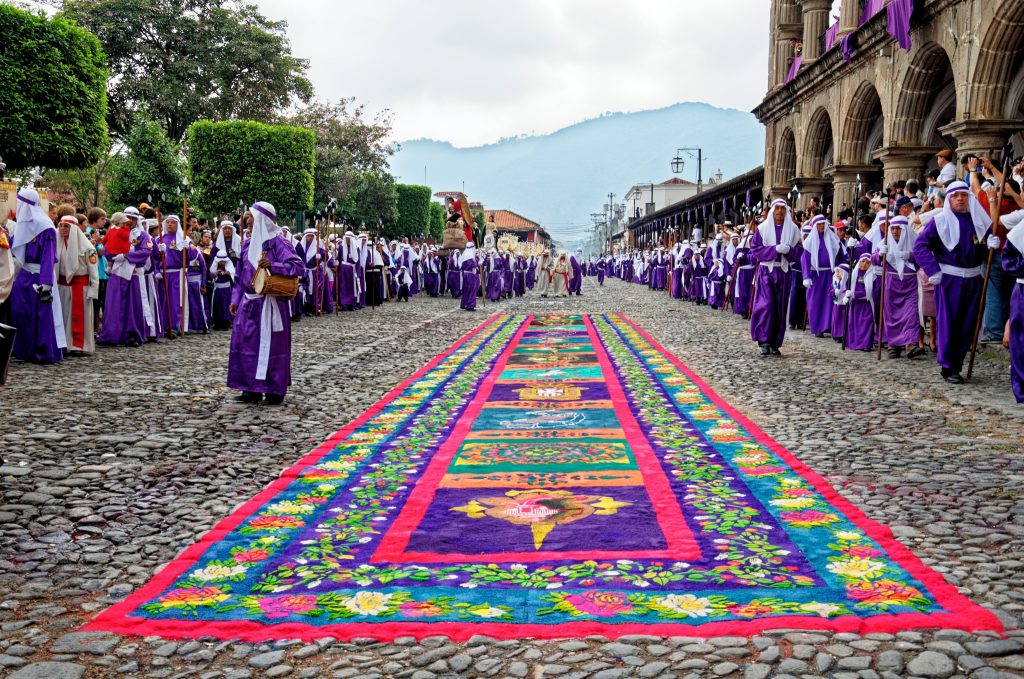
Some say alfombras originated from an even older Spanish tradition of laying down palm branches or flower petals before a holy procession passed by. Over time, Guatemalans began to create their own versions—first with pine needles and flowers, then adding dyed sawdust, fruits, vegetables, and all kinds of materials found in homes and markets.
The alfombra became not just a gesture of reverence, but an offering—something beautiful and temporary, created in silence or alongside family and neighbors, then destroyed as a symbol of humility and sacrifice.
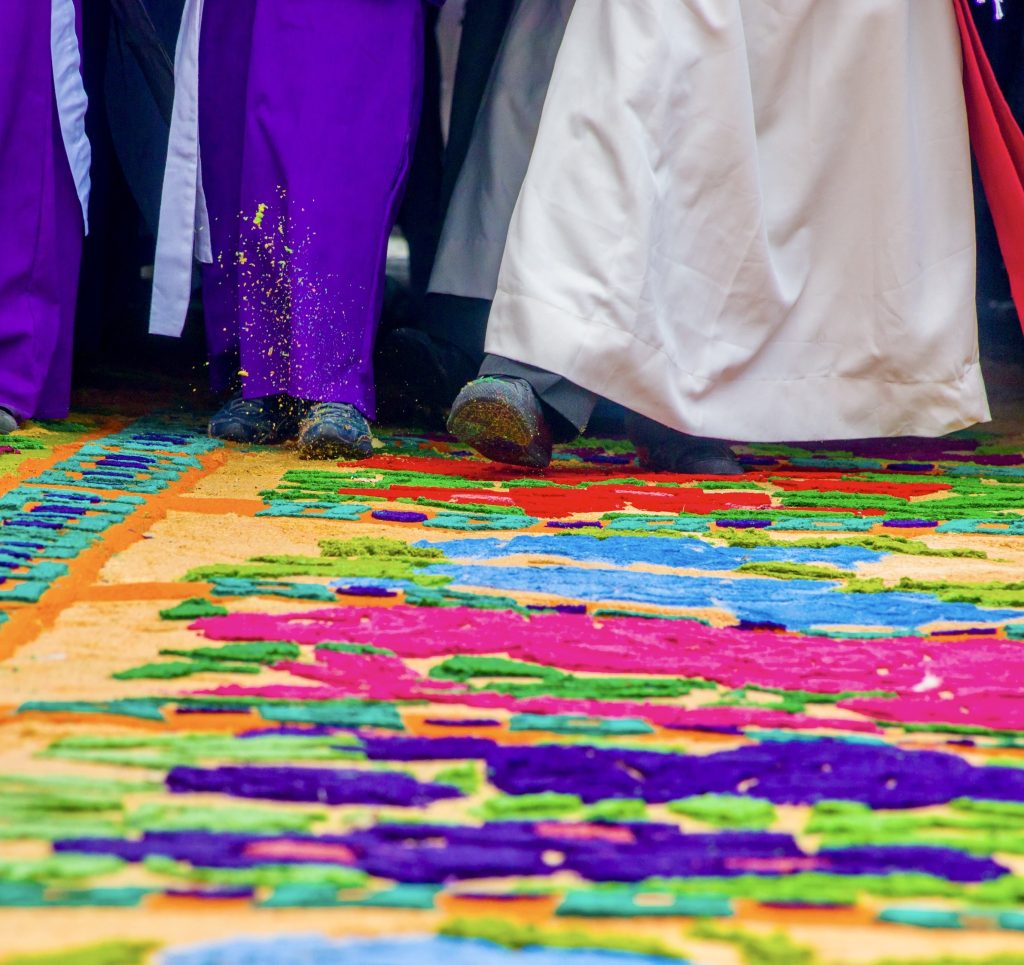
I remember asking a neighbor in Antigua one year why they spent all night working on a carpet that would be gone in five minutes. She said, “Because it’s not about how long it lasts. It’s about giving the best of yourself—even if it disappears.”That stayed with me.
Today, alfombras are a symbol of Guatemalan identity. They reflect faith, yes, but also artistry, collaboration, and love for tradition. Whether you’re religious or not, seeing these carpets up close—and understanding the work behind them—gives you a real sense of how much this celebration means to people.
How Alfombras Are Made: From Backyard Flowers to Works of Art
Making an alfombra is both a labor of love and a community ritual. In Semana Santa in Antigua Guatemala, it’s not uncommon to see entire families—sometimes three generations—working side by side through the night to finish their section of carpet before the morning procession arrives. Whether it’s a simple floral design or a jaw-dropping sawdust masterpiece, the process always starts the same: with care, patience, and a deep sense of purpose.
A Personal Memory from Antigua
When my mom lived in Antigua in my early twenties, a small procession passed right in front of her house. She had a jacaranda tree in the yard, and I still remember gathering the soft purple blossoms that had fallen overnight. Each family on the block claimed a patch of the street, using pine needles and flowers from their garden to make simple, geometric designs. It wasn’t perfect, but that wasn’t the point. It was ours.
From Simple Designs to Elaborate Masterpieces
Today, many alfombras are far more elaborate. Artists sketch their designs weeks in advance. Families and cofradías use stencils to apply dyed sawdust in intricate layers, carefully spraying it with water to hold the colors in place.

How an Alfombra Comes Together
-
The street is swept and leveled—often with sand or sawdust to create a flat surface.
-
Designs are drawn or traced, either freehand or with large cardboard stencils.
-
Dyed sawdust is sifted layer by layer, forming crisp lines and bright color.
-
Details are added—petals, fruit, vegetables, seeds, candles, pine needles, and more.
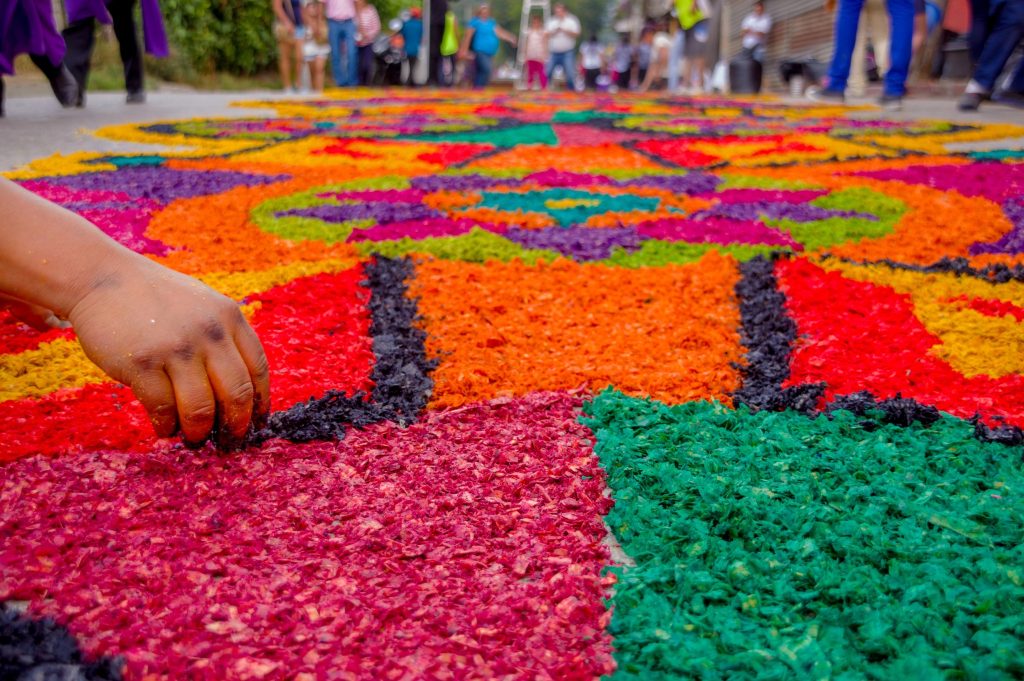
It can take 8–20 hours or more to finish a single carpet. Some are built overnight; others, block by block during the day, just hours before the procession arrives.
But no matter how big or small, the intention is the same: to create something meaningful, to give your best, even knowing it will be gone in minutes.
When and Where to See the Best Alfombras in Antigua
If you’re planning to experience the sawdust carpets of Semana Santa in Antigua Guatemala, timing and location make all the difference. While you’ll find alfombras throughout Lent, the most impressive and densely packed streets of color appear during Holy Week, especially on Holy Thursday and Good Friday.
Best Times to See the Carpets
Your best chance to see the carpets fully intact is early in the morning, right before the processions begin. By midday, the floats (andas) begin to pass, and with them, the carpets are slowly trampled—intentionally, as part of the ritual. It’s bittersweet, but beautiful.
Some locals walk the streets at 4 or 5 a.m. to catch the first light on the fresh carpets, especially on Good Friday. I’ve done that walk myself—camera in hand, the streets still quiet, the only sound being early morning birds and the soft scrape of final touches on the sawdust. It’s one of the most peaceful and awe-inspiring parts of the week.
Where to Go for the Most Stunning Alfombras
You can find alfombras almost everywhere in Antigua during Holy Week, but here are a few of the best spots year after year:
-
Calle Ancha de los Herreros – This wide street is a popular route for major processions and is known for its large, intricate carpets.
-
Around Iglesia de La Merced – One of the most photographed areas, thanks to the stunning backdrop and devotion of nearby residents.
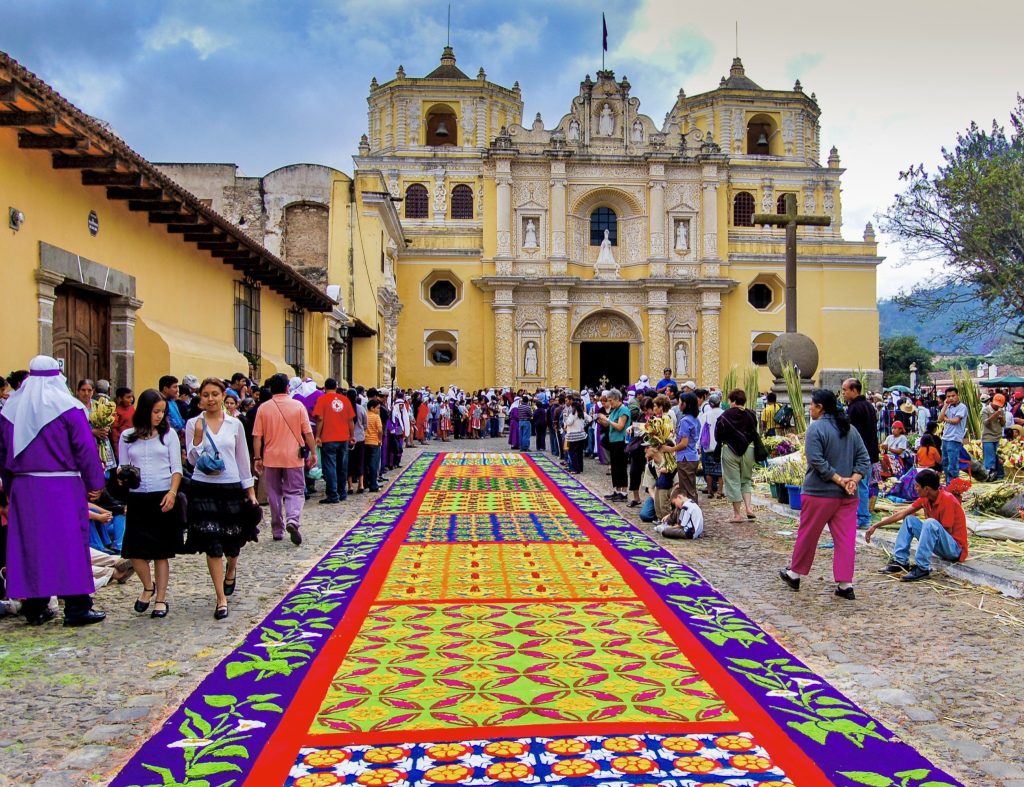
-
Parque Central and Cathedral Area – Many important processions pass here, and the streets are lined with alfombras made by locals, schools, and artisan groups.
-
Barrio de San Bartolomé Becerra – A bit more off the beaten path, but known for beautiful and less crowded carpets.
If you’re staying in town, just follow the scent of incense and corozo—or better yet, ask a local what street their family is working on. They’ll probably be happy to point you to something special.
- Great Wolf Lodge Con Adolescentes: Nuestra Experiencia y Mejores Consejos - septiembre 8, 2025
- Vacaciones en Palm Beach con Adolescentes: Actividades Diferentes para Conectar en Familia - agosto 6, 2025
- Qué hacer en Daytona Beach con adolescentes: un viaje familiar antes de la universidad - agosto 3, 2025


